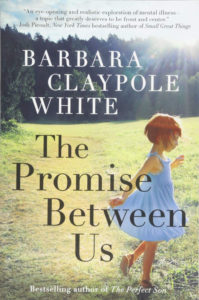The Promise Between Us, Back Story
Since writing The Unfinished Garden, I’ve wanted to revisit OCD with a story about the impact of anxiety on relationships. Obsessive-compulsive disorder is so destructive, so twisted, so relentless, and yet there’s a popular misconception it’s about hand washing and the anal organization of sock drawers. Even though I’ve been married to someone with OCD for nearly thirty years and our grown son has battled OCD since he was four, my learning curve continues—sometimes in ways that are heartbreaking.
Many of us in the OCD community are active in confidential support groups. Someone in one of those groups talked about her battles with pedophile OCD, and her comments were leaked to her employer. She was fired. Her story haunted me for months and led me to think about the darkest corners of OCD, the ones that still carry unbearable shame.
Meanwhile, I was chewing on an old story idea—one I couldn’t quite ditch—about a single dad whose wife had run away when his daughter was a baby. His daughter, now a teen, hit a mental health crisis, and through her journey, he discovered his wife had struggled with the same illness. When I showed the synopsis to my brilliant creative writing major son, he highlighted one sentence—scratched out the rest—and said, “That’s your story, Mom.” I had found my premise: Can you be a good mother if you abandoned your baby? Then I started researching postpartum OCD, which often manifests as violent thoughts and images (commonly referred to as harm OCD).
After the name Maisie MacDonald popped into my head and stuck, I had a sense of her parents’ heritage and started fleshing out their backstories. Key elements came from strange places. At a Raleigh book club, one reader asked why I always write about UNC and Duke, but not NC State, which led to Callum’s job. And I found Katie at the hairdresser’s. I was admiring a piece of artwork in the salon when the wonderful stylist Angela Goldman said, “You should meet the artist, Jackie MacLeod. She’s a girlie welder.” That phrase did it: girlie welder. The next day I emailed Jackie and discovered the Liberty Arts Sculpture Studio & Foundry in Durham. Around the same time, I had a day to kill in Raleigh and went to the CAM, where I discovered the docent program. (And the Videri Chocolate Factory.) Bingo!
As always, I enjoyed finding and excavating my secondary characters. Jake was inspired by a photo of the actor Gabriel Byrne; Lilah came out of a conversation with a friend about the problems of being a stepmom; and Ben grew out of my fascination with a local sculptor, famous for his work in metals and motion.
The final piece of the story came after my writing buddy Sheryl Cornett invited me to give a talk at her church. That evening three young people shared stories of struggling with mental illness without access to affordable health insurance, which triggered a new story angle. I already knew Callum struggled with anxiety, but as I researched the reason why, I found many parallels between Callum’s backstory and Katie’s. One parallel in particular caught my attention: I realized that while lack of money prevented Katie from seeing a therapist, shame achieved the same result for Callum. They both tackled their problems without professional help, and the marriage had suffered as a result. Finally I had circled back to my original idea: I was writing a story about the impact of anxiety on a relationship.
